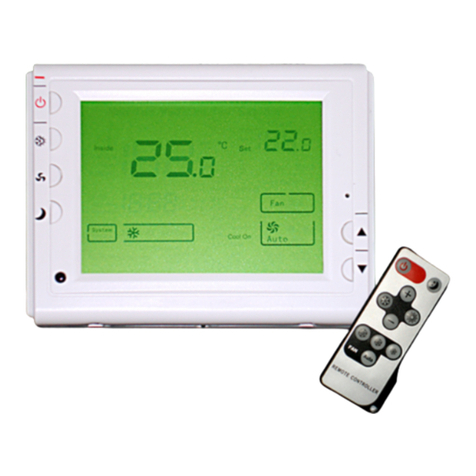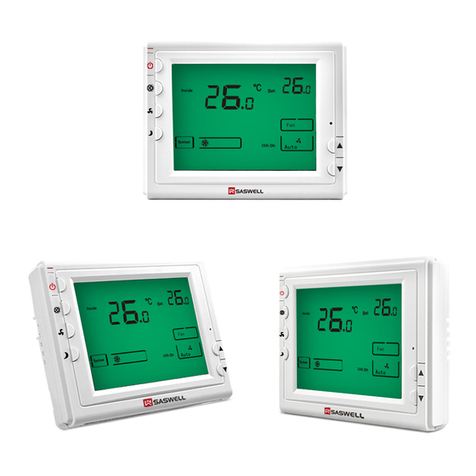
Item Press buttons Displayed(factory
default)
Press▲、▼to select Description
1 (4) For 5 second FC (℃) ℃/℉ Select ºF or ºC Readout
2 (4) CL (0) -3 --- +3 Select temperature display adjustment higher
or lower
3 (4) CH (35℃/95℉) 18 ℃ (64 ℉ )—35 ℃ (95
℉)
Select maximum setpoint
4 (4) CC (5℃/41℉) 5℃(41℉)—20℃(68℉) Select minimum setpoint
5 (4) UC (25℃/77℉) 25℃(77℉)-30℃(90℉) Select setback point for cooling
6 (4) UH (18℃/65℉) 10℃(50℉)- 18℃(65℉) Select setback point for heating
7 (4) PH (2) 0-10 Select P-band
8 (4) LP (5) 1-10 Integral action time
9 (4) FH (100) (50-100) Maximum integral part
10 (4) FL (0) (0-50) Minimum of integral part
11 (4) bL (1) 1/2/3 Select display backlight mode
12 (4) HF (h1) h1/OF/h2 Heating output type option
13 (4) En (AC) OU/AC Active temperature sensor
OU:Return air temperature sensor active
AC:Room temperature sensor active
AU: Mix temperature sensor active
13 (4) rC (SC) SC/OC/OO Activate energy saving mode option
14 (4) U (I) U: 0–10 VAC output
I: 4 - 20 MA output
Choose the control mode between 0~10VAC
output to 4~20MAoutput
15 Press Power Button return to close
3) Select maximum temperature set point
This feature provides a maximum set point temperature. The default setting is 35℃(95℉), It can be
chan
int temperature. The default setting is 5℃(41℉), It can be
chan
nt temperature for heating. The default setting is 16℃, It can
be ch
t for cooling etpoint temperature for cooling. The default setting is 25℃, It
band is the amount of change required by the ambient temperature for the output to
ged between 18℃(64℉) to 35℃(95℉)
4) Select minimum temperature set point.
This feature provides a minimum set po
ged between 5℃(41℉) to 20℃(68℉)
5) Select energy saving setpoint for heating
This feature provides energy saving setpoi
anged between 10℃to 18℃
6) Select energy saving setpoin
This feature allows you to set energy saving s
can be changed between 25℃to 30℃
7) Select P-band
The proportional
go from 0 to 100%. It can be adjust from 0~10℃. Factory default setting is 2℃. For example if the
6




























